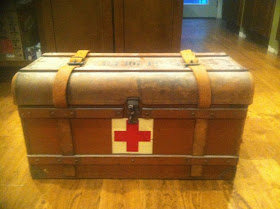Donern was poking around in his grandfather's attic when he discovered this vintage Japanese medical chest. The paperwork inside apparently dates it to 1932, and there's some speculation in the comments that it may have been a naval first aid kit. History porn like this provides a great example of how prop items dating to the same era should look. Plus, you know, it's really cool.



I read the thread fully and it appears to be an army unit chemical warfare treatment kit, which explains the odd collection of medicine. Being that it is dated to 1932, the horrors of WWI gas attacks should have been fairly fresh in military minds a little over a decade after the War to End All Wars. Phosgene, chlorine, and mustard gas were employed in Europe during WWI and caused 1.2 plus casualties. Many survivors continued to suffer all their lives from lingering effects.
ReplyDeleteChemical agents were primarily used against unprepared peoples in remote areas during the interwar years by major powers bent on conquest or repressing rebellion in colonial areas. Numerous treaties had been signed, some as early as 1899 to eliminate the use of chemical weapons, but in the end, deterrence was the major factor leading to the demise of chemical agents in major wars.
The Japan used limited chemical and biological agents in China, most as testing during the Sino-Japanese conflict, but would have never dreamed of unleashing the monster on Allied troops for fear of retaliation. The Allies had huge stockpiles of chemical weapons during WWII as well as chemical defense equipment for men, women, and children. There were even gas ensembles for baby cribs, strollers and masks for horses it was taken so seriously.
The case is really of historical consequence being intact. I have never seen a Japanese CWD kit before. It is indeed a time capsule of a period between the wars. Note the way the case seals well along the opening and the metal inner seal with the two handles. In a way this construction can be traced to the earlier making of traditional trunks and cases called Tansu. Further off the subject, consider reading about Tansu for your prop makers, which would enhance your knowledge of box and cabinet making. Some books of interest on the subject: Japanese Cabinetry: The Art & Craft of Tansu Hardcover by David Jackson and Dane Owen (I’ve read this one) and Tansu: Traditional Japanese Cabinetry Paperback by Ty Heineken (which I have not yet read)